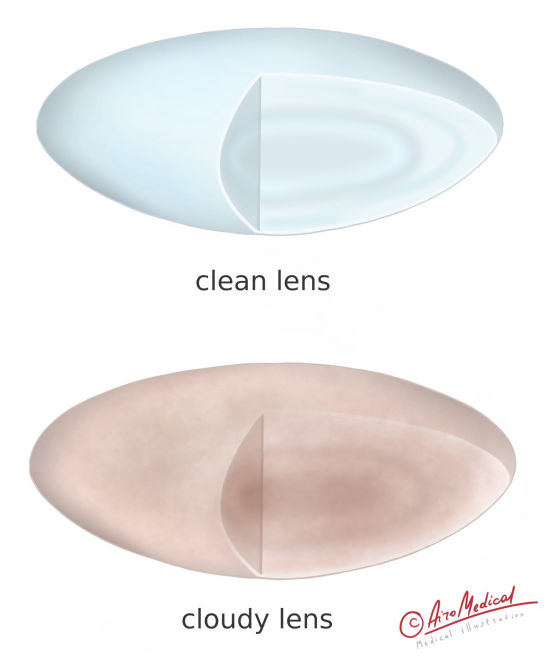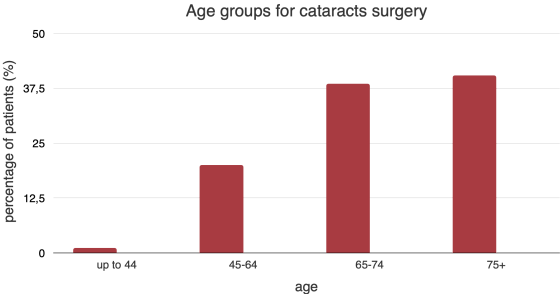Cataracts guide
 What are cataracts?
What are cataracts?
 A cataract is a clouding or loss of transparency of the eye's natural lens. It is because the proteins contained in the lens are destroyed and stick together. Moreover, the disease eventually leads to vision loss and, in individual cases, blindness.
A cataract is a clouding or loss of transparency of the eye's natural lens. It is because the proteins contained in the lens are destroyed and stick together. Moreover, the disease eventually leads to vision loss and, in individual cases, blindness.
The condition affects one in six people over the age of 60. Lens damage is the most common cause of poor vision in the elderly and a cause of blindness worldwide.
Several reasons can cause the disease, but the most common is natural ageing. Cataracts can also develop after an injury or certain medications. However, seldom children might be born with congenital cataracts.
The most common type is formed mainly in the centre of the eye's lens- a nuclear cataract. Another type of cataract develops at the edge of the lens and is called a cortical cataract. Finally, a cataract that forms at the back of the lens is called a posterior capsular cataract.
 Diagnostic tests
Diagnostic tests
The lens lesion develops rather slowly, and the early stages may not be noticeable. One of the reasons why people often don't realize they have a cataract is that the disease develops painlessly. As it progresses, the following symptoms appear:
- Blurred vision;
- Decreased colour perception;
- Contrast issues, especially at night;
- Increased sensitivity to light and glare;
- Distorted vision, including halos around lights and double vision.
An ophthalmologist can check for cataracts as part of a comprehensive eye exam. The examination is simple and easy, but additional procedures may be needed, such as:
- A visual acuity test consists of reading letters from a distance.
- Slit Lamp Examination - a special microscope with a bright light allows the doctor to examine different parts of the patient's eye.
- Inspection of the retina - with the help of special drops, the pupils dilate. It allows the doctor to see the retina, and the cataract is seen better.
An eye exam can help detect cataracts and other vision problems at their earliest stages. It is why regular check-ups with an ophthalmologist are so important.
 Treatment methods
Treatment methods
The facts about cataracts are clear. Once the disease begins to develop, vision will gradually deteriorate. And a pleasant truth about cataracts is that it is possible to cure them and restore lost vision!
Changing glasses or contact lens prescriptions may be enough to help when the disease is just beginning. But because cataracts get worse with age, many people need more intense care.
There is no other way to cure or get rid of a cataract once it has formed than surgery. Unfortunately, no medicine can reverse the existing changes, and no glasses can completely neutralize their effects. Some ophthalmologists are looking for non-surgical solutions, but no other solution has been found at this time.
There are several types of cataract surgery, but they all have one similar thing: the clouded lens is removed and replaced with an artificial one.
- In minimally invasive surgery or the so-called phacoemulsification - the surgeon makes a tiny incision in the cornea. Next, a small device is placed in the eye that emits ultrasonic waves that destroy the clouded lens. Then the doctors take out the destroyed pieces and insert an artificial lens.
- Large incision surgery - this is recommended for significant cataracts that cause more vision problems than usual. It is sometimes called extracapsular cataract extraction. The surgeon removes the entire cloudy lens and replaces it with an artificial one. It takes a little longer for the patient to heal after this operation than after surgery with a small incision.
Cataract surgery is usually performed on an outpatient basis using local anaesthesia.
 New treatment options
New treatment options
There have been many advances in cataract surgery in recent years, including with the help of a laser and an instrument called intraoperative aberrometry (ORA), which takes a different eye measurement during surgery. It allows more accurate proportions of the synthetic lens used to replace the original lens.
- Femtosecond laser surgery. A camera/ultrasound device is placed over the patient's eye to map its surface. It also collects all information about the eye. The device sends the results to a computer that programs the laser. It tells the laser the incisions' exact location, size and depth. The surgeon may use a laser to make an incision in the cornea and a hole in the capsule. They can also use laser energy to soften cataracts. The ultrasonic sensor breaks the lens apart and sucks them out. The surgeon then places an artificial lens in the eye. A laser incision usually does not require stitches.
Ophthalmologists do not leave hope for the medical treatment of cataracts. However, the study results on a revolutionary new treatment for cataracts have been published in the Investigative Ophthalmology and Visual Science journal. The oxysterol compound, which has been proposed as an anti-cataract drug, has been clinically tested.
- Treatment with oxysterol compound VP1-001 - under the drug's influence, the lens's protein organization is restored, and the lens focuses better. According to the results of studies, the focusing ability of the lens improves in 61% of cases, and opacification decreases in 46% of patients.
 Statistics and prognosis
Statistics and prognosis
- According to the World Health Organization (WHO), the disease is the leading cause of blindness worldwide. Approximately 51% of blindness worldwide is the result of cataracts. And this is about 20 million people.
- More than 2 million cataract surgeries are performed annually in the US alone.
- The chance of being in a car accident after cataract surgery is reduced by 13%.
- Those who have undergone cataract surgery have a 40% lower mortality rate than those who have had untreated cataracts. In addition, with clearer vision, people who have surgery can see better and avoid hazards such as oncoming traffic, an unexpected curb or a step.
- Cataract surgery is more accessible than ever, with costs down 85% since 1985.
The results of cataract surgery are extremely high. The American Society of Cataract and Refractive Surgery (ASCRS) estimates a 98 % success rate. Among patients who underwent cataract surgery from 2004 to 2021, 99.5% had no adverse side effects or complications. By age groups, patients are distributed as follows: up to 44 years old - 1.1%; 45-64 - 20%; 65-74 - 38.5%; 75+ - 40.4%.

People no longer have to live with vision loss due to cataracts. Thanks to new technological advances, cataract surgery today has become faster, more efficient and more comfortable for the patient. If an illness limits your daily activities, such as reading, driving, or watching TV, book a consultation with a specialist. AiroMedical is a guarantee of successful cataract surgery anywhere in the world.
References:
- Ophthalmology Physicians & Surgeons, PC: A Brief Look at Cataract Statistics
- American Academy of Ophthalmology: Traditional Cataract Surgery vs. Laser-Assisted Cataract Surgery
- MyVision.org: Natural Remedies to Cataracts: Do These Actually Work?
- О ScienceDirect: Distribution gaps in cataract surgery care and impact on seniors across Ontario
- NIH: Eye Health Data and Statistics
- Anglia Ruskin University: Drug treatment for cataracts moves a step closer